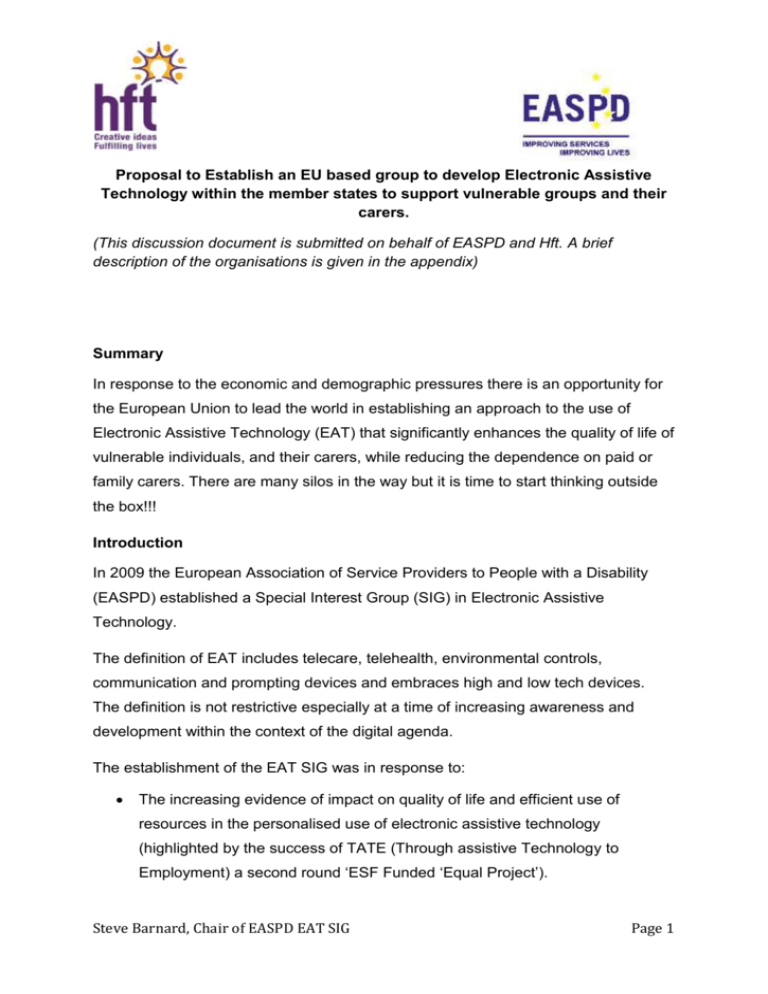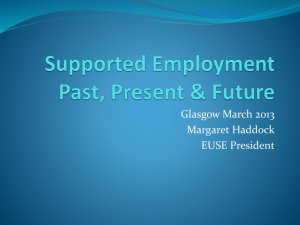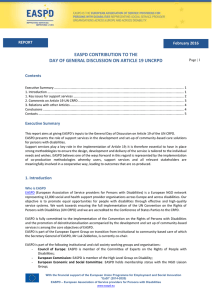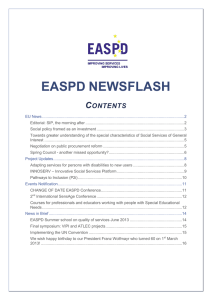Proposal to Establish an EU based group to develop Electronic
advertisement

Proposal to Establish an EU based group to develop Electronic Assistive Technology within the member states to support vulnerable groups and their carers. (This discussion document is submitted on behalf of EASPD and Hft. A brief description of the organisations is given in the appendix) Summary In response to the economic and demographic pressures there is an opportunity for the European Union to lead the world in establishing an approach to the use of Electronic Assistive Technology (EAT) that significantly enhances the quality of life of vulnerable individuals, and their carers, while reducing the dependence on paid or family carers. There are many silos in the way but it is time to start thinking outside the box!!! Introduction In 2009 the European Association of Service Providers to People with a Disability (EASPD) established a Special Interest Group (SIG) in Electronic Assistive Technology. The definition of EAT includes telecare, telehealth, environmental controls, communication and prompting devices and embraces high and low tech devices. The definition is not restrictive especially at a time of increasing awareness and development within the context of the digital agenda. The establishment of the EAT SIG was in response to: The increasing evidence of impact on quality of life and efficient use of resources in the personalised use of electronic assistive technology (highlighted by the success of TATE (Through assistive Technology to Employment) a second round ‘ESF Funded ‘Equal Project’). Steve Barnard, Chair of EASPD EAT SIG Page 1 The lack of awareness, information, skills and training in service providers in the use and provision of EAT. The confusion in the service chain delivery. The emphasis in the provision of EAT reflects a medical model of care and focuses on the disability or the specific vulnerable group. TATE highlighted that using specific technological solutions to address issues, identified by a more personalised approach or assessment (such as safety in the bathroom, or anxiety of being left alone etc) can achieve significant more success than traditional models of, for instance, telecare. TATE proposed an ethical context that has been further developed within the UK and is forming part on the initiative within ‘ImPaCT in Europe’, part of which is looking at how an ethical context is required to underpin a personalised approach to the use of EAT. Progress EASPD EAT SIG receives no structural funding and since 2009 its activities has been, to a great extent, subsumed by ‘ImPaCT in Europe’ a Leonardo project. Although there are clear strides being made, particularly by the E-Inclusion Department and the impact of the Digital Agenda, there is more scope to further develop an EU, and nationally based, strategies to respond to the possibilities of using EAT in a personalised way. Drivers It is accepted that the provision of support for people identified as part of a vulnerable group is mainly provided by people, either paid carers, or families. The appropriate and personalised use EAT can increase the independence of both the individuals and their carers. It can reduce the need for people to be dependant on others whilst increasing their independence. This can both reduce cost and increase health, wellbeing and opportunities for employment. The economic climate coupled with the growing demographic pressures is focusing the mind as to how the needs of the vulnerable groups and their Steve Barnard, Chair of EASPD EAT SIG Page 2 carers are going to be addressed in the coming years especially if the principles of personalisation and rights of individuals are to be maintained. The UN Convention on Rights of People with Disabilities puts human rights at the heart of its desire to see people with disabilities included as part of main street society. There are many references to the need to increase the opportunity for people to benefit from assistive technology. The Digital Agenda places digital competence and skills at the heart of helping the member states out of the recession. Part of this agenda must be to ensure that members of vulnerable groups and their carers also benefit both for them as individuals and to raise their contribution to society. Barriers to the Market Place As well as a confused and essentially a medical model of service delivery the provision and development of EAT is led by manufacturers. The purchasers of specialist EAT devices are providers of services and not the individual themselves. This restricts the influence of current and potential users on the use and development of EAT. Allowing that the majority of people with disabilities do not live in supported services access to EAT is consequently limited. There are many ‘silos’ that inhibit access and development to EAT: o Lack of policy initiatives o Health vs. Social sector o Disability labels and separate structure solutions (rather than an issue led approach). o Confused and inadequate funding streams o Lack of Training or lack of funding for training Steve Barnard, Chair of EASPD EAT SIG Page 3 o Lack of scientific evidence The Challenge 1. How can the EU ensure that EAT is made available to the majority of its population in the most appropriate way to ensure maximum benefit to their quality of life whilst significantly addressing dwindling resources? 2. How can the EU change to focus of the use of EAT from a service delivery chain based on the medical model of care to a more consumer led market and consumer responsive market? Proposal The EU and EASPD explore how the current EAT SIG could be developed to support a broader initiative to see how the above challenge can be met. There are three distinct markets that need to be addressed: 1. The formal service delivery via providers 2. The increasing individual budget market 3. People outside any formal support structure. It is unclear as to what legal entity would be most appropriate to support such a development. It is proposed an initial start up fund be sought with a business plan for the ‘entity’ to become self sufficient in a three year period. The ‘entity’ would be expected to work in partnership with user groups, carer groups, the statutory sector and manufacturers. Financial self sufficiency could be developed from Evidence based research Specific Projects (around use and impact of different technologies or technology platforms) Pilots of new technologies Steve Barnard, Chair of EASPD EAT SIG Page 4 Influence design Getting products to market (scaling up) Development of an ethical framework Membership of other organisations Developing awareness, training (on line and blended) and consultancy (free at source to individuals but commissioned by purchasers or providers). The above proposal in consistent with policy initiatives suggested at both an einclusion led stakeholder day and a Digital Agenda stakeholder day both in October 2010. Both policy suggestions that are based on providing a proactive group to take the use of EAT forward are clearly early initiatives in bringing the EU2020 policy to life. Appendix – Description of Organisations EASPD EASPD is the EUROPEAN ASSOCIATION OF SERVICE PROVIDERS FOR PERSONS WITH DISABILITIES and promotes the equalization of opportunities for people with disabilities through effective and high quality service systems in Europe. Today, EASPD represents over 8000 service provider organizations across Europe and across disability. We believe in interdependence and partnership of user organizations, service providers and authorities at all levels to tackle the challenges ahead. EASPD plays a key role on a European level as a representative of disability NGOs and non-profit organisations in working for an inclusive Europe. EASPD wants to significantly influence European disability & socio-economic policy by having a permanent presence in Brussels and by working with other European and international networks. Hft Steve Barnard, Chair of EASPD EAT SIG Page 5 Hft is a national charity providing local support for people with learning disabilities and their families. Our creative and resourceful approach supports individuals to make choices about the life they want. People with learning disabilities and their families talk to us about all types of support. Working together we find the best individual solutions. Our flexible approach means we can offer the right support from as little as two hours a week to twenty four hours a day. We work with over 1,000 people with learning disabilities across the UK and 4,000 family carers through our Family Carer Support Service.Hft has gained a reputation within the UK and increasingly across the rest of Europe as leaders in the use of personalized technology Steve Barnard, Chair of EASPD EAT SIG Page 6






